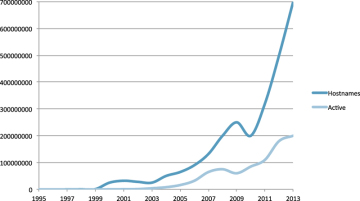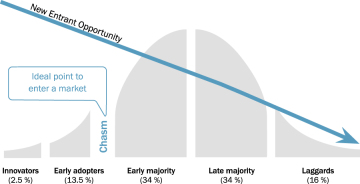When It Comes to Your Online Startup, Timing Is Everything
- Innovation adoption curve
- Commoditization of technology
- The value of network effects
- “In the publishing business, you’re either first, you’re fabulous, or you’re f***ed!”
- —ANONYMOUS
Everyone’s heard the story about Isaac Newton sitting under an apple tree while developing the theory of gravity. Imagine the opportunities that existed in Newton’s time, in the early days of modern science, to have a profound impact through relatively simple and foundational contributions. Today, you would need to deduce exceedingly complex theories about quantum physics and the existence of “god” particles to have even a fraction of the impact Newton had.
The same holds true today, at the end of the Internet’s golden age. There are countless stories in recent memory of those who set up websites and made a million dollars. Google AdWords used to provide easy advertising opportunities in which lead generation and affiliate marketers could generate profound traffic—for pennies on the dollar of the income that traffic could generate. Even getting free traffic through Google’s and Yahoo’s organic search results was fairly easy, as the search algorithms were less sophisticated and the amount of competition was far less than now.
There was a popular idea floating around during the golden age that the Internet was the great equalizer. It brought democratization to the marketplace. It was the beginning of a new economy in which previous power structures were neutralized and anyone could start a business that reached everywhere, and had the same opportunity for success as anyone else. Ah, the good ol’ days!
Today, the cost of AdWords equals or exceeds the value of the traffic it generates for many entrepreneurs (an issue of volume/size). Organic search results are heavily biased toward the largest and most established websites, with the proverbial wind of years of backlink history at their backs. Public companies have also started actively promoting their websites on television and through other major media, effectively doing end-runs around other online discovery-oriented channels. Not only has power begun to consolidate around major brands, there’s also the issue of too much ambient noise. To illustrate this point, take a look at Figure 4.1. Netcraft.com has been keeping track of new websites since its inception and reports that, as of March 2012, there are 13 million active websites worldwide—a seven-fold increase since 2005.1 No wonder it’s begun to feel so crowded!

Figure 4.1. Active host names.
In 2007, the iPhone, a new delivery platform, hit the market and instantly provided an unexploited opportunity to create content for these new devices. Those who moved quickly were able to garner the download counts that now drive placement in the App Store. Today, just five short years later, there are over 700,000 iPhone apps, and 60 percent of those actually lose money (compared to the cost of development).2
If we look at these examples, the immediate conclusion might be that it’s too late to make any money online. It’s not, though it is a lot more difficult if you weren’t there in the beginning when the field was wide open.
Time and again, startups have made a lot of money very quickly by being at the right place, at the right time. This was true in the golden age of science, in the American industrial revolution, and in the Internet and mobile revolutions. Today the opportunities are smaller and require greater time and capital to be competitive. The rare exception is if your idea takes off in the social web. But for most it’s a hard slog to see returns.
Against this backdrop, imagine what would be possible if you were in the right place at the right time. The good news is that innovation and opportunity are still happening around us all the time. The key is to find the emerging opportunities and align your startup with those opportunities. Let’s take a look at a framework that can prove helpful.
Innovation adoption curve
In 1962, sociologist Everett Rogers developed the Innovation Adoption Curve, a bell curve distribution model that describes the absorption of innovation into culture. Geoffrey Moore further added an adoption chasm that exists between innovators and early adopters (Figure 4.2).
Rogers’s and Moore’s work has mostly been applied to the adoption of a specific technology or product, but it could also be applied to macro technologies and trends. For example, the Internet was originally developed by the U.S. Defense Advanced Research Projects Agency (DARPA) in the 1950s (innovators). It was improved through the use of TCP/IP protocols in 1982. But the first commercial applications didn’t really begin until the introduction of Netscape in the early 1990s (early adopters), and it snowballed from there a few years later, as the early majorities arrived.

Figure 4.2. Everett Rogers’s Innovation Adoption Curve.
This conceptual framework can be useful for analyzing timing of trends, in order to see the windows of entrepreneurial opportunity. We assume at a macro level that innovators are the academics and scientists creating pure innovation without application, the early adopters are the first to see opportunity for commercial application and either evangelize or commercialize it, and the consumers are the early/late majorities and laggards.
Take a look around your everyday life through the lens of this framework: Innovators are less than 2.5 percent of scientists and academics innovating without application. Early adopters follow with first attempts to apply the concepts with novelty products and in government defense work. The early majority are the first consumers to buy in, perhaps for social status purposes, similar to owning an iPhone in 2008. The late majority are busy pragmatists who cannot invest time until something has proven its value. And laggards are the grandparents who just signed up for Facebook to see the most recent pictures of the grandchildren.
There’s something to be said for looking around you and observing the current level of adoption of an innovation before you attempt to commercialize it. The best commercial opportunities begin just as the late majority arrives, but you must have already built your product and gained some momentum before that time, which means you must be begin building your business before the early majority. And thus the chasm!
The chasm might also be ideal as you can minimize adoption risk by letting it play out just a little bit in that early adopter phase before investing yourself. Certainly, though, you would not want to enter the market after the late majority phase, as competitors are already entrenched and your window for capitalizing on the innovation before it is commoditized is minimal.
Perhaps the best recent example of this is the mobile market. In 2007 Apple introduced the iPhone and revolutionized the smartphone industry. But the raw innovation had been out there since the late 1990s. There were even HTTP and WAP-enabled phones prior to the iPhone, but none had gained much traction. These were the early adopters. The iPhone was the product that was needed to give enough bounce to overcome the chasm and lead the industry into early majority. Apple enjoyed dominance over the early majority phase until Google hit the market with Android, a free competitive platform, and this led to a proliferation of competitive devices and marked the beginning of the late majority phase. Android was able to compete because it’s free and Google has massive pull as a company. The introduction of the Android platform marked the entry into the late majority and the beginning of commoditization of the industry.
The takeaway is that one can enter the market late, as Google did, but (a) you better have significant money to spend to build momentum and catch up, and (b) you should be a large business that can be a cost leader and make money on volume, since commoditization is soon to set in. Because of the late-market timing, your role will be to lead the commoditization on the way down the backside of the curve, not up. This is a role suitable only for a major organization, not a small startup that will need the early majority evangelists to gain momentum.